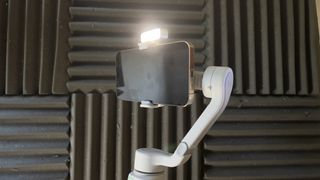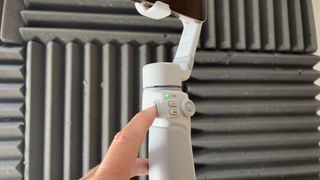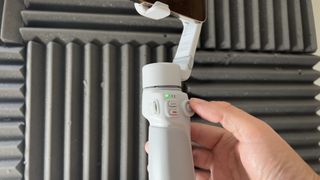Digital Camera World Verdict
The ZHIYUN Smooth Q4 Combo enables you to perform professional and disciplined camera moves on your smartphone while keeping the footage stable and the horizon level. You can make the gimbal pan and tilt, zoom in or out of your subject and trigger the recording with one hand thanks to the Bluetooth connected app on your smartphone. It will help elevate your camera moves to a more professional level.
Pros
- +
Gets up and running quickly
- +
Magnetic fill light
- +
Tracks your every move
- +
Long battery life
Cons
- -
Noticeable compression in HYPERLAPSE clips
- -
Poor image stitching in PANO mode
Why you can trust Digital Camera World
The Smooth Q4 is the latest smartphone gimbal from ZHIYUN, a company with an experienced track record of making a wide range of professional and consumer camera stabilisers since 2014. I’ve owned a ZHIYUN Z1-Evolution gimbal since 2018 and it performed very well with a GoPro.
However, these days I tend to take advantage of the professional video quality of the iPhone 13 Pro, so I need a smartphone gimbal like the Smooth Q4 to capture precise moves such as pans and tilts as well as tracking and crane shots. The iPhone 13 Pro does have built-in optical image stabilisation, but not when using its ultra-wide lens.
The 3-axis Smooth Q4 enables me to capture striking wide-angle shots with no shake while keeping my horizon level at all times (as you’ll see from the test video that will pop up on this page). The joystick on the rear of the gimbal also enables me to perform pans and tilts handheld without the need for a tripod.
Specifications
Battery Life: 10 hours
Tilt range: 338º
Roll range: 338º
Pan range: 331º
Weight: 370g
Dimensions: 181.7 x 107.7 x 56.3mm
App: ZY CaMi
Extendable pole: 215mm
Key features



As with most budget stabilisers, the ZHIYUN Smooth Q4 is a 3-axis gimbal that enables you to tilt, pan and roll your iPhone (depending on which mode you set it to). Usually the roll x-axis will be used to keep the attached smartphone’s horizon level at all times (which is hard to do when you move a handheld smartphone without stabiliser assistance.)
The Smooth Q4 has a Mode button on the rear to change the behaviour of the gimbal. For example the lock (L) mode keeps the smartphone pointing in the same direction while F causes it to pan and tilt to follow your hand movements. A trigger at the front lets you triple tap to change the iPhone’s orientation from landscape mode (for traditional 16:9 widescreen filmmakers) to portrait mode (for vertical social media content on sites such as TikTok).
Many of the Smooth Q4’s features are unleashed when you link it via Bluetooth to the ZY CaMi app running your gimbal mounted smartphone, as we’ll explore in the Performance section.
There’s also an attachable mini tripod that enables you to use the gimbal handsfree (which is actually very useful as we demonstrate in our supporting test video.) The Combo kit also features a storage bag to protect the gimbal when its in transit (and it holds other accessories such as the magnetic fill light.)
Build and handling



In relation to build and performance, the ZHIYUN Smooth Q4 is very similar to the rival DJI OM 5 smartphone stabiliser. As well as having similar grey plastic and silicone bodies, both gimbals have a telescopic rod that extends by 215mm, enabling you to capture a wider field of view when filming selfies.
The DJI OM 5 boasts a magnetic smartphone clamp that makes it quicker and easier to attach your smartphone to the gimbal. However, the Smooth Q4 Combo kit ships with a removable magnetic fill light that helps illuminate dark locations.
You can buy a magnetic clamp that has a built-in light for the DJI OM 5, but this costs extra. The Smooth Q-4 Combo kit has a somewhat higher retail price, but that does include the fill light.
Performance

As you’ll see from our test video, the Smooth Q4 does a great job of keeping the horizon level while panning, tilting and craning an iPhone 13 Pro mounted on the stabiliser. However, when shooting using the ultra-wide lens we occasionally captured some of the gimbal’s roll motor at the edge of the frame.
The Smooth Q4 was strong enough to keep our larger iPhone Pro Max nice and stable, but in landscape orientation the Max ran the risk of bumping into the tilt axis when held at certain angles. All the footage in our test video was shot on the smaller iPhone 13 Pro.
What really impressed us was the way the gimbal could be controlled by the free ZY CaMi app. When connected via Bluetooth to the smartphone app, you can rotate the dial on the left of the gimbal and zoom in or out of your subject. A press of the dial turns on the magnetic fill light mounted at the top of the gimbal. A tap on the record button lets you start and stop recording. You can perform all of these operations with one hand while simultaneously making your camera moves. Without the gimbal you’d need two hands to operate the iPhone. One to hold it and the other to tap the screen.
When the gimbal is mounted on its tripod you can switch to the smartphone’s selfie camera and use gesture control (raising your palm) to trigger Follow+Shoot mode. This causes the gimbal to track your face wherever it goes. The app does a great job of panning and tilting the gimbal as you walk around – as if you had a camera person with you on location. Watch our supporting video the see this useful and impressive feature in action.
The app also provides other shooting modes that aren’t as impressive. The HYPERLAPSE mode lets you shoot time lapse style sequence while on the move, but the resulting video compression artefacts are really noticeable in footage captured using this mode. PANO mode causes the gimbal to rotate and shoot a series of consecutive images which it then stitches together as a wider composite shot. The stitching between the edge of each image is often noticeable as horizontal lines are misaligned. However these are small niggles compared to the gimbal’s overall excellent performance when it comes to capturing smooth tilts, pans and tracking shots.
Verdict
The Smooth Q4 is an adequate smartphone gimbal that’s on par with the DJI OM 5 in relation to price, features and performance. If you want a faster way to attach your smartphone to a gimbal then the OM 5’s mount has a magnetic clamp that might sway you to buy that device.
If you want a gimbal that ships with a magnetic fill light that illuminates your selfies then you may lean towards the Smooth Q4 Combo.
These two gimbals shouldn’t bust your budget, but for a cheaper alternative you could consider the lower-priced FeiyuTech Vimble 3, which also ships with app-enabled controls and a mini-tripod.
Read more:
• Best smartphone gimbals
• Best GoPro gimbal
• Best iPhone tripods
• Best video lights
• Best iPhone microphones
George has been freelancing as a photo fixing and creative tutorial writer since 2002, working for award winning titles such as Digital Camera, PhotoPlus, N-Photo and Practical Photoshop. He's expert in communicating the ins and outs of Photoshop and Lightroom, as well as producing video production tutorials on Final Cut Pro and iMovie for magazines such as iCreate and Mac Format. He also produces regular and exclusive Photoshop CC tutorials for his YouTube channel.

